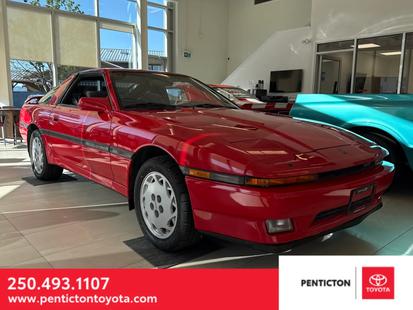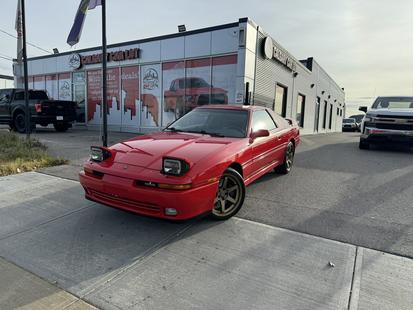The Toyota Supra, a legendary sports car that has captured the hearts of enthusiasts worldwide, stands as a symbol of performance and style. Known for its sleek design and impressive performance capabilities, the Supra has carved a niche in the sports car market, offering a blend of Japanese engineering with a touch of European influence.
History and Background
The Toyota Supra traces its roots back to the late 1970s when it debuted as a performance-oriented version of the Toyota Celica. Over the years, it gained a reputation for its powerful inline-six engines and became a cult favorite, especially with the introduction of the fourth generation in the 1990s. After a hiatus, Toyota revived the Supra in 2019, collaborating with BMW to create a modern sports car that honors its heritage while incorporating cutting-edge technology.
- Key Dates:
- 1978: Original Supra debuts as a Celica variant.
- 1993: Fourth-generation Supra launches, becoming an icon.
- 2002: Supra production ceases.
- 2019: Fifth-generation Supra reintroduced after a long hiatus.
- 2021: Toyota introduces a four-cylinder engine option for the Supra.

2021 Toyota GR Supra 3.0t Low Kilometers Navigation
$64,990
8,925 miles

Used 1988 Toyota Supra 5 Speed Manual
$34,995
66,336 miles

1990 Toyota Supra
$29,000
110,355 miles
Performance and Handling
| Variant | Engine | Power | 0-60 | Top Speed | Fuel Economy |
|---|---|---|---|---|---|
| 2.0 | 2.0L I4 | 255 hp | 5.0s | 155 mph | 25/32 mpg |
| 3.0 | 3.0L I6 | 382 hp | 3.9s | 155 mph | 22/30 mpg |
Interior and Comfort
| Feature | Base | Mid | Top |
|---|---|---|---|
| Leather Upholstery | - | ✓ | ✓ |
| Heated Seats | - | ✓ | ✓ |
| Dual-Zone Climate Control | ✓ | ✓ | ✓ |
| Premium Sound System | - | ✓ | ✓ |
Technology and Features
Technology by Model Year:
- 2019: Introduction of infotainment system with navigation
- 2020: Addition of Apple CarPlay
- 2021: Launch of Toyota Safety Sense suite
Infotainment System:
- Screen size: 8.8 inches
- Features: Navigation, Apple CarPlay, Bluetooth connectivity
- Connectivity: USB ports, wireless charging (optional)
Driver Assistance Features:
- Standard: Pre-collision system, Lane departure warning, Adaptive cruise control
- Optional: Blind-spot monitoring, Rear cross-traffic alert
Safety
The Toyota Supra has performed well in crash tests, showcasing its robust construction and advanced safety technologies. Its array of driver assistance features adds to the overall safety, making it a reliable sports car choice.
Safety Ratings:
- NHTSA Rating: 5 stars
- IIHS Rating: Good
Safety Features:
- Standard: Pre-collision system, Lane departure alert, Adaptive cruise control
- Optional: Blind-spot monitor, Parking sensors
Value for Money
| Year | Condition | Price Range |
|---|---|---|
| 2019 | Excellent | $45,000 - $50,000 |
| 2020 | Good | $40,000 - $45,000 |
| 2021 | Fair | $35,000 - $40,000 |
Running Costs:
Running a Toyota Supra is relatively affordable compared to other high-performance sports cars. It boasts decent fuel economy and reasonable service intervals, though some parts can be pricier due to its performance nature.
- Fuel Economy: 25 city / 32 highway / 28 combined (2.0L)
- Service Intervals:
- Oil Change: 10,000 miles
- Major Service: 30,000 miles
- Common Repair Costs:
- Brake pads: $300-$500
- Turbocharger: $1,500-$2,500
Known Issues by Year:
- 2019: Some reports of infotainment glitches
- 2020: Minor issues with adaptive cruise control
Competitor Comparison
Competitor 1: Ford Mustang
- Market Position: The Ford Mustang is a well-established American muscle car with a strong fan base, offering a variety of powertrains and a reputation for performance.
- Features Comparison: The Mustang offers more variety in terms of engine options, but its interior quality and technology may not match the Supra's premium feel.
- Price Comparison: Generally more affordable than the Supra, especially in lower trims.
- Running Costs: Similar in terms of fuel economy, though repair costs can be higher for higher-performance variants.
Competitor 2: BMW Z4
- Market Position: The BMW Z4, sharing its platform with the Supra, targets the luxury roadster segment, offering open-top driving with similar performance credentials.
- Features Comparison: The Z4 offers a more luxurious interior and additional customization options, though at a higher price point.
- Price Comparison: Generally more expensive due to its luxury branding and additional features.
- Running Costs: Higher maintenance costs, typical of luxury German vehicles.
Competitor 3: Chevrolet Corvette
- Market Position: The Chevrolet Corvette is a direct competitor in the sports car category, known for its powerful V8 engines and iconic American design.
- Features Comparison: Offers superior horsepower and a mid-engine layout, providing a unique driving experience.
- Price Comparison: Slightly higher starting price, but offers more performance for the money.
- Running Costs: More expensive due to higher fuel consumption and maintenance costs associated with a high-performance V8.
Verdict
The Toyota Supra successfully blends performance, style, and reliability, making it a top choice for sports car enthusiasts. Its collaboration with BMW has produced a vehicle that pays homage to its heritage while offering modern technology and driving dynamics. Though it faces stiff competition, the Supra stands out with its balanced offering of performance and everyday usability, making it a worthy contender in its segment.